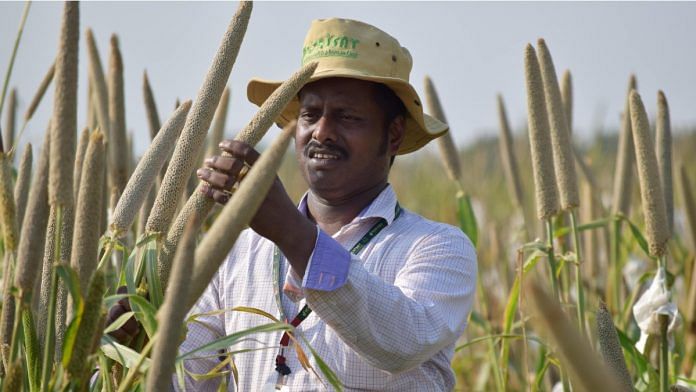New Delhi: Telangana-based agriculture scientist Mahalingam Govindaraj has won the coveted 2022 Norman E. Borlaug Award for Field Research and Application for developing a variety of pearl millet rich in iron and zinc.
The variety, named Dhanashakti, is the world’s first biofortified pearl millet or bajra which was released for cultivation in 2014.
“Govindaraj is recognised for his outstanding leadership in mainstreaming biofortified crops, particularly pearl millet, in India and Africa,” the World Food Prize Foundation said in a statement on 30 August.
It added that for over a decade, Govindaraj directed the development and dissemination of high-yielding, high-iron and high-zinc pearl millet varieties which contributed to better nutrition for thousands of farmers and their communities.
Govindaraj is currently a senior scientist for crop development at HarvestPlus, which works to promote production and consumption of biofortified staples. Biofortification is a process of selective breeding to increase productivity and micronutrient content of crops.
The award was constituted in 2011 in the memory of Norman E. Borlaug whose work as a young scientist in Mexico in the 1940s and 1950s was instrumental in the fight to eradicate global hunger and poverty.
Endowed by the Rockefeller Foundation, the $10,000 award is presented every October in Iowa, the US, to recognise the work of an individual scientist under the age of 40.
India adopted high-yield dwarf wheat varieties developed by Borlaug during the Green Revolution beginning in the mid-1960s which made the country self-sufficient in food production.
“It is an honour to receive an award named after Dr Borlaug who has been an inspiration and whose footsteps I have followed while disseminating the new varieties to farmers,” Govindaraj told ThePrint.
“[Ever] since Dhanashakti was released in 2014, we have released about 10 biofortified pearl millet varieties in India and West Africa. Now the private sector is selling these seeds to farmers.”
He added that other than millets, the technology of biofortification — early work on which was led by Howarth Bouis since 2003 — is being adopted for other staples like rice, wheat, maize, cassava and corn.
According to the World Food Prize Foundation, 200 grams of Dhanashakti can provide women with more than 80 per cent of their recommended daily allowance of iron, compared to only 20 per cent in regular varieties of pearl millet.
It is estimated that by 2024, more than 9 million Indians will be consuming the biofortified varieties of millets leading to improved nutritional standards. Farmers in West Africa have also adopted new biofortified varieties since 2019.
According to HarvestPlus, the first biofortified food crop, a Vitamin A enriched sweet potato, was released in 2004. Since then, hundreds of biofortified varieties of 12 different staple crops have either been released or are in testing phases in more than 60 countries.
Globally, biofortification is now used as one of the several ways to fight hidden hunger or micronutrient deficiency. The other strategies are promoting dietary diversity, post-harvest fortification of food, and providing vitamin, iron and folic acid supplements to targeted groups like pregnant women and lactating mothers.
(Edited by Tony Rai)
Also Read: What’s fortified rice, why is Modi govt pushing it & why some experts aren’t excited



